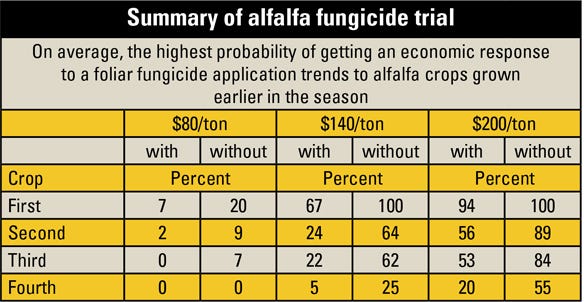February 12, 2018

The use of foliar fungicide on alfalfa is a popular topic among growers. Despite the lack of improved forage quality in most small-plot university trials, somewhat consistent and statistically significant yield responses have been achieved.
Farmer testimonials suggest that some growers are observing a positive response to fungicide application. The main question is if the yield increase is large enough to make the fungicide application profitable.
Over the past six years, we conducted 16 site-years of foliar fungicide research trials with alfalfa at the Iowa State University Northeast Research and Demonstration Farm at Nashua. With the help of farm superintendent Ken Pecinovsky, we evaluated weather conditions, application timing and alfalfa varieties for foliar fungicide treatments when determining cost-effectiveness and yield response to the treatments.
Just as with fungicide applications for corn and soybeans, you need to select opportunities with alfalfa as to where the probability of economic return is greatest. To apply fungicides to alfalfa without much thought to harvest schedule or environmental conditions doesn’t follow proper stewardship of pesticide use, nor would it result in maximizing profit.
To spray or not to spray
According to the results of our studies, here are factors to consider when using foliar fungicides in alfalfa production:
• First-crop benefit. On average, the trials suggest that the first crop or harvest provides a higher percent yield response to a foliar fungicide application than for later crops. Three main factors contributed to this are that spring environments are usually more favorable for alfalfa diseases; yield potential for first crop is higher than for later crops; and growth period for first crop is considerably longer than that of later crops.
• Hay price important. For example, a 10% yield increase from a fungicide application doesn’t add as much value to hay at $80 per ton hay as at $200 per ton. Thus, yield per cutting plus yield response to fungicide plus hay price are all critical in contributing to profitability.
• Low rainfall in summer. For trials that summer, disease incidence was low and yield response to fungicide treatments only averaged about 5%. This resulted in a net loss to fungicide treatments even with hay priced at $200 per ton. However, the fungicide treatments during an extremely wet spring in 2013 resulted in some of the most profitable net returns. In general, the wetter the climate the better the chance to achieve a profitable response to a foliar fungicide application.

• Right canopy height. Targeting about a 5-inch canopy height for second, third and fourth crop is advisable, while waiting for a 6- to 8-inch canopy is ideal for treating the first crop. Some trials compared timing of fungicide applications at a 3- to 4-inch canopy versus a 6- to 8-inch canopy. Since foliar fungicides only protect what they are applied to, an application to the 6- to 8-inch canopy should offer more protection. Although there were small numerical differences in disease reduction and yield response with these treatments favoring later application, they were not statistically significant.
However, to wait for an 8-inch canopy height for second, third or fourth crop in a four-cut system could be problematic in that the fungicide products have a 14-day preharvest interval. A compromise is suggested by targeting a 5- to 6-inch canopy height for these applications. However, it is preferred to treat first crop alfalfa at a 6- to 8-inch canopy height for better coverage and to take advantage of its longer regrowth period before harvest.
• Increased yield. Main reason to use foliar fungicides is to achieve increased yield, and you shouldn’t necessarily count on increased forage quality. It’s reasonable to assume that if foliar fungicide applications reduce disease infestations, leaf retention may be improved and result in higher forage quality at harvest. To interpret forage quality differences in some of the ISU trials, subsamples were sent to forage testing labs. Even though there was some visual evidence of better leaf retention, fungicide applications showed little to no improvement in forage quality.
• Resistance ratings. There are no industry standards in place to provide leaf disease ratings for alfalfa varieties to aid in the decision of foliar fungicide use in alfalfa production. Some trials included two alfalfa varieties. Variety A averaged 14% lower in leaf disease incidence than variety B and yielded better than variety B in absence of a fungicide treatment, but both yielded the same when treated with a fungicide. It is understandable that alfalfa varieties may have different tolerances to leaf diseases. However, there are no standards for leaf disease resistance ratings, therefore no recommendations for use of a foliar fungicide based off of ratings.
Lang is an ISU Extension field agronomist based at Decorah in northeast Iowa. Contact him at [email protected].
About the Author(s)
You May Also Like






